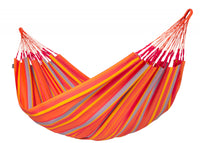Children make discoveries about the world around them every day. They are full of energy and can hardly be stopped while playing, romping, and tumbling. But after an action-packed day, they also need time to unwind. However, children can get bored quickly with down time. So, what do our little ones need to find peace amid all their experiences and process their feelings?
The staff at the Mothers and Family Center – referred to as MütZe – in the Rheinhessen region of Ingelheim, Germany, have also pondered this question. Since the beginning of 2021, they have been pursuing an unconventional approach to provide children with a retreat in their eventful everyday lives. In collaboration with LA SIESTA, the team has equipped its premises with several children's hammocks (Moki) and hanging nests (Joki). In today's Siesta Story, we take you to MütZe and show you how hammocks have changed the daily routine of both children and educators.
MütZe - A Place of Gathering
As a Mothers and Family Center, MütZe serves as a meeting point for family members of all ages. The focal point is the care provided for infants and school-age children. Through the Kinderhaus Kunterbunt (Colorful Children's House), MütZe operates an inclusive daycare center where childrens' creativity and imagination can unfold and develop freely. For school-age children, MütZe offers an after-school program - children aged 6 to 14 gather here after classes. They receive individual assistance with homework and can participate in After school activities alongside other students. In addition to caring for children and adolescents, MütZe also provides advice on topics such as parenting, law, and migration. At MütZe, people of all generations come together and find support for questions that are relevant to families.
Space for Relaxation
The everyday routine at MütZe is always centered around the needs of children. Therefore, when deciding where to place children's hammocks and hanging nests, their imagination had to be taken into account. After trying out the Moki and Joki in the gym, the children used drawings to show educators where in MütZe's space they would like to "hang out." Ultimately, the products found their place in the room for homework assistance and in a cozy corner of the Kinderhaus Kunterbunt. To integrate the Moki and Joki into the existing spaces, a few changes had to be made, and a part of the previous setups rearranged. According to daycare center manager Sabrina Köhn, however, this is not a disadvantage: "The space is simply used differently," she explains during our visit to MütZe. She also praises the high flexibility in setting up and taking down LA SIESTA products. Moki and Joki can be easily removed when needed and later rehung with a few simple steps. As a result, the hammocks are also used when needed in the gymnasium belonging to MütZe.

Sharing Hammock Fun at Kinderhaus Kunterbunt
An Oasis of Calm and Imagination
With Moki and Joki, the MütZe team has created an oasis of relaxation and shared experiences for the children. They can get comfortable, read a book, listen to a story, or simply daydream. This is especially beneficial for children with disabilities or behavioral challenges. During our visit, Sabrina Köhn reported that even very lively children enjoy retreating to the hammocks and hanging nests. She noticed that the little ones feel secure in Moki and Joki and emphasized that it's a valuable experience for children to be in touch with their own bodies while unwinding.
When conflicts arise between children in MütZe's daily routine, the hammocks also serve as a place where they can pause and de-escalate. However, the staff at MütZe haven't observed any disputes over the Moki and Joki. The children regulate among themselves who gets to "hang out" at what time, and they often make themselves comfortable in pairs or groups of three.
In hammocks, the children find not only tranquility and relaxation but also incorporate LA SIESTA's products creatively into their play. They enjoy inventing their own stories revolving around Moki and Joki - for example, they play as butterflies emerging from the hammocks like cocoons.

Relaxed Hours spent in MütZe's Outdoor Area
Harmony Always Resonates
The positive impact of hammocks on togetherness is clearly palpable at MütZe. Before the children arrive for the day, the educators also like to make themselves comfortable in a Moki or Joki, so they also benefit from the use of LA SIESTA products. Sabrina Köhn feels that the community at MütZe has become even more harmonious since the children's hammocks and hanging nests were introduced. "At MütZe, we follow a situation-oriented approach," she explains. "We don't dictate anything to the children; we simply provide impulses that they can implement. It's truly wonderful to observe how the children retreat to the hammocks and play with each other.“

Play and Fun with the Children's Moki Max Hammock
Integral Part of Daycare Routine
Parents are also noticing how much Moki and Joki enrich life at MütZe. While they initially associated the hammocks and hanging caves mainly with idleness, they now realize how positively they affect the well-being and interactions among the children. However, the LA SIESTA products bring the most joy to the children themselves. "They have become an integral part of our daily lives," notes Sabrina Köhn.

Moki and Joki have become indispensable in daily life at MütZe.
A post by: Elena Gaber



